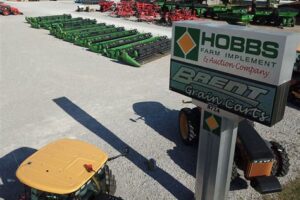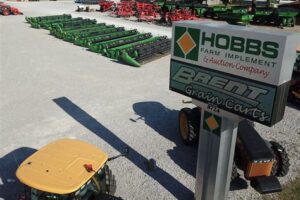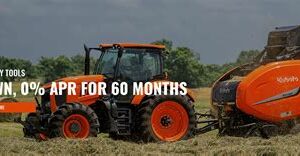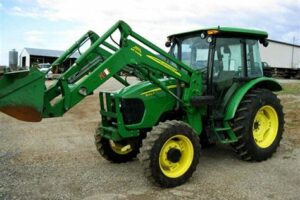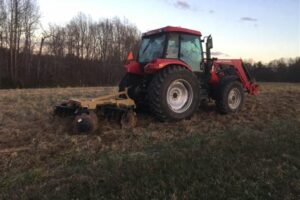Table of Contents
Discover the charm of horse-drawn antique farm equipment. Explore a range of meticulously restored plows, harrows, wagons, and more, showcasing the ingenuity of a bygone era. Immerse yourself in the nostalgia and history as you witness these beautifully preserved pieces that once played a vital role in agricultural practices. Experience the timeless allure of rural life with horse-drawn antique farm equipment.
When one thinks of antique farm equipment, images of rusty tractors and plows may come to mind. However, there is a hidden gem among these relics that often gets overlooked – horse-drawn antique farm equipment. These magnificent pieces of machinery not only represent a bygone era in agriculture but also showcase the ingenuity and craftsmanship of the past. From the elegant curves of a wooden plow to the intricate ironwork of a harrow, these horse-drawn implements have the power to transport us back in time and give us a glimpse into a world where horsepower meant something entirely different.
Horse Drawn Antique Farm Equipment
In the early days of agriculture, before the advent of modern tractors and machinery, horses played a crucial role in farming. These magnificent animals were relied upon to pull various types of antique farm equipment, helping farmers perform a range of tasks necessary for their livelihoods. Today, horse-drawn antique farm equipment serves as a reminder of the ingenuity and hard work that went into cultivating the land. In this article, we will explore some of the fascinating examples of horse-drawn antique farm equipment and their historical significance.
The Plow
One of the most iconic and essential pieces of horse-drawn antique farm equipment is the plow. This tool was used to break up and turn over the soil, preparing it for planting crops. The plow consisted of a blade or moldboard that dug into the earth while being pulled by one or more horses. Farmers would guide the plow and adjust its depth to ensure proper soil cultivation.
The Harrow
After plowing, the harrow was used to further prepare the soil. This piece of horse-drawn antique farm equipment had rows of spikes or discs attached to a frame. As the horses pulled the harrow, these spikes or discs would penetrate the soil, breaking up clumps and leveling the surface. The harrow ensured a smooth and even seedbed, enhancing the chances of successful crop growth.
The Seeder
Once the soil was properly prepared, the seeder came into play. This horse-drawn equipment allowed farmers to accurately distribute seeds across the fields. The seeder had compartments or hoppers that held the seeds, which were released through adjustable openings. As the horses walked along the rows, the seeder would ensure an even distribution of seeds, saving time and effort compared to manual sowing.
The Reaper
Harvesting crops was a labor-intensive task, but the invention of the reaper made it more efficient. The reaper was a horse-drawn machine that cut and gathered crops such as wheat. It featured a cutting mechanism and a reel that collected the cut crops into bundles or sheaves. Once the bundles were formed, workers could then tie them together to create manageable bundles for transportation and storage.
The Thresher
After the crops were harvested, the next step was to separate the grains from the chaff. The thresher was a horse-drawn machine used for this purpose. It featured a rotating drum with paddles or beaters that would break open the harvested crop, separating the grains from the straw. The grains would fall through the screen while the straw was expelled from the machine. The thresher greatly expedited the process of separating the valuable crop from its waste material.
The Wagon
The wagon was an indispensable piece of equipment for transporting harvested crops, tools, and other materials across the farm. Horse-drawn wagons were designed with sturdy frames, wooden or metal beds, and large wheels to navigate uneven terrain. They provided farmers with a means to move heavy loads efficiently, allowing them to transport their produce from the fields to storage or markets.
The Cultivator
Keeping the soil free from weeds was crucial for crop health and productivity. The cultivator was a horse-drawn implement used to remove weeds and loosen the soil around growing plants. It featured multiple curved blades or teeth that would dig into the ground, uprooting weeds while breaking up the soil’s crust. The cultivator helped ensure optimal growing conditions and reduced competition for nutrients between crops and weeds.
The Hay Rake
For farmers who relied on hay for livestock feed, the hay rake was an essential tool. This horse-drawn equipment was used to gather cut hay into rows or windrows, allowing it to dry more efficiently before baling or stacking. The hay rake had a series of tines or teeth arranged in a row, which would collect the hay as the horses pulled it along. This equipment greatly simplified the process of collecting and preparing hay for storage.
The Water Cart
In areas where access to water was limited, the horse-drawn water cart provided a valuable solution. This equipment consisted of a tank or barrel mounted on a wagon, capable of carrying a significant amount of water. Farmers could use the water cart to transport water to various parts of the farm, ensuring crops and animals had access to much-needed hydration. The water cart was especially useful during dry spells or in remote locations.
The Corn Sheller
Processing corn by hand was a time-consuming task until the invention of the corn sheller. This horse-drawn machine efficiently removed the kernels from the cob. It featured a rotating drum with small indentations that would catch the ear of corn and strip off the kernels. The separated corn could then be used for various purposes such as livestock feed or grinding into cornmeal. The corn sheller revolutionized corn processing on farms.
These are just a few examples of the horse-drawn antique farm equipment that played a vital role in early agricultural practices. Each piece represented a step towards increased efficiency and productivity, allowing farmers to cultivate the land and provide for their communities. Today, these artifacts serve as a testament to the hard work and determination of those who came before us, shaping the foundation of modern farming.
Horse-Drawn Antique Farm Equipment: Preserving History and Nostalgia
Introduction
Horse-drawn antique farm equipment holds a significant place in agricultural history. These remarkable artifacts offer a glimpse into a bygone era when horses were the primary source of power on the farm. In this article, we explore the importance and unique characteristics of horse-drawn antique farm equipment.
1. Historical Significance: A Testament to Farming Heritage
Horse-drawn antique farm equipment represents the backbone of early agricultural practices. These machines symbolize the ingenuity and craftsmanship of farmers who relied on their innovation to increase productivity. Preserving and studying these artifacts helps to honor the contributions of previous generations while gaining insights into their way of life.
2. Functional Design: Integrating Form and Function
The design of horse-drawn antique farm equipment seamlessly combines practicality with aesthetic appeal. Crafting each piece to suit specific farming needs, manufacturers paid equal attention to durability, efficiency, and elegance. These artifacts demonstrate the intricate balance achieved between utility and artistry, making them coveted items for collectors and history enthusiasts.
3. Multifaceted Utility: Versatile Farming Implements
Horse-drawn antique farm equipment was remarkably versatile, fulfilling a wide range of agricultural tasks. From plows and seed drills to hay rakes and cultivators, these tools were designed to assist farmers in various stages of crop production. Understanding the diverse functionalities of these machines provides valuable insights into the farming practices of the past.
4. Artisanal Craftsmanship: Preserving the Legacy of Skilled Tradesmen
Each horse-drawn antique farm equipment piece is a testament to the artistic excellence and craftsmanship of skilled tradesmen of yesteryears. These artifacts were meticulously handcrafted and often showcased intricate detailing. Appreciating the dedication to quality and the skills of these craftsmen highlights the human element, eclipsed by modern-day automation.
5. Evocative Nostalgia: Reviving Farming Memories
Owning and using horse-drawn antique farm equipment evokes a sense of nostalgia, transporting us to a simpler time. Maintaining and restoring these items allows us to bridge the generation gap and teach younger generations about traditional farming methods. Reviving farming memories through these artifacts fosters a profound appreciation for technological advancements in agriculture.
6. Educational Value: Learning from the Past
Horse-drawn antique farm equipment serves as an invaluable educational tool for agricultural history enthusiasts, museums, and educational institutions. Studying their intricate mechanisms, evolution, and adaptations helps us understand the challenges faced by farmers in the past and the innovative solutions they devised. This historical knowledge enables us to make informed decisions and address present-day farming problems.
7. Collectible Rarity: Unique Pieces of Agricultural History
Due to their scarcity and historical significance, horse-drawn antique farm equipment pieces have become highly sought-after collectibles. Enthusiasts and collectors prize these artifacts for their historical value and aesthetic appeal. Owning such unique items connects the present generation with the past, preserving a tangible link to our agricultural heritage.
8. Symbol of Sustainability: Rediscovering Traditional Agricultural Practices
With the increasing focus on sustainability and reducing carbon footprints, horse-drawn antique farm equipment offers modern farmers an opportunity to explore traditional agricultural practices. Embracing the use of horses for farm work promotes resource conservation, fosters a deeper connection with nature, and serves as a reminder of the importance of sustainable farming methods.
Conclusion
Horse-drawn antique farm equipment encapsulates the rich history, ingenuity, and nostalgia associated with traditional farming practices. This unique collection of artifacts represents the resilience of the human spirit and our ability to adapt to changing times. Preserving, studying, and appreciating these remarkable pieces of agricultural history is vital for honoring the accomplishments of previous generations while embracing sustainable future farming practices.
Point of View: Horse Drawn Antique Farm Equipment
As a professional in the agricultural industry, I firmly believe that horse-drawn antique farm equipment holds significant value and should not be forgotten. Here are some key points to consider:
-
Historical Significance:
Horse-drawn antique farm equipment allows us to connect with our agricultural roots and appreciate the history of farming. These tools were instrumental in shaping the way agriculture was conducted in the past and played a crucial role in feeding communities. Preserving and utilizing these artifacts allows us to honor our ancestors’ hard work and dedication to the land.
-
Environmental Benefits:
Using horse-drawn antique farm equipment promotes sustainable farming practices. Unlike modern machinery that relies on fossil fuels, these tools harness the power of horses, reducing carbon emissions and minimizing our ecological footprint. This traditional approach aligns with the growing demand for organic and eco-friendly farming methods.
-
Cost-Effective Solution:
Employing horse-drawn antique farm equipment can be a cost-effective alternative for small-scale farmers or those with limited financial resources. While modern machinery requires substantial investments, maintaining and operating horse-drawn equipment can be more accessible and affordable in the long run. Additionally, these tools are often built to last, showcasing durability and reliability.
-
Enhanced Soil Health:
The use of horse-drawn antique farm equipment can have positive effects on soil health. Unlike heavy tractors that compact the soil, horses distribute their weight more evenly, reducing soil compaction and preserving its fertility. This practice allows for better water infiltration, root development, and overall soil structure, leading to improved crop yields.
-
Education and Cultural Preservation:
By utilizing horse-drawn antique farm equipment, we have the opportunity to educate future generations about traditional farming techniques and their cultural significance. These tools can be incorporated into educational programs, museums, or living history farms, giving people a hands-on experience and a deeper understanding of our agricultural heritage.
In conclusion, horse-drawn antique farm equipment should not be overlooked in modern agriculture. Their historical value, environmental benefits, cost-effectiveness, positive impact on soil health, and educational potential make them an invaluable asset to the farming community. Let us continue to appreciate and utilize these tools while promoting sustainable and efficient farming practices.
Thank you for visiting our blog on Horse Drawn Antique Farm Equipment. We hope that you have found the information and insights shared here to be informative and engaging. As we conclude this article, we would like to leave you with some final thoughts on the significance and value of preserving these timeless pieces of agricultural history.
First and foremost, antique farm equipment provides us with a tangible link to our past. These machines serve as a testament to the ingenuity and hard work of those who came before us. They remind us of the challenges and triumphs of early farmers, who relied on horse-drawn equipment to cultivate the land and feed their communities. By preserving and showcasing these artifacts, we pay tribute to their legacy and ensure that future generations can appreciate the rich history of agriculture.
Moreover, horse-drawn antique farm equipment offers us a unique perspective on the evolution of technology in agriculture. It is fascinating to see how these simple yet ingenious machines have paved the way for the advanced equipment used today. From plows and cultivators to seeders and harvesters, each piece tells a story of innovation and progress. By studying and understanding these early technologies, we gain valuable insights into the challenges faced by farmers in the past and the solutions they devised.
Lastly, horse-drawn antique farm equipment serves as a reminder of the importance of sustainable and environmentally friendly farming practices. In an era where modern machinery often relies heavily on fossil fuels and synthetic chemicals, it is refreshing to look back at a time when horsepower literally meant the power of a horse. These machines relied on renewable energy sources and promoted a more balanced and harmonious approach to farming. By reflecting on these practices, we can learn valuable lessons about the potential benefits of incorporating sustainable methods into modern agriculture.
We hope that this blog has inspired you to appreciate the beauty and historical significance of horse-drawn antique farm equipment. As you continue to explore the world of agriculture, we encourage you to delve deeper into this fascinating field and discover the many stories that these artifacts have to tell. Thank you once again for joining us on this journey, and we look forward to sharing more captivating insights with you in the future.
.
People also ask about Horse Drawn Antique Farm Equipment:
- What is horse drawn antique farm equipment?
- Why do people collect horse drawn antique farm equipment?
- How do you identify horse drawn antique farm equipment?
- Where can I buy horse drawn antique farm equipment?
- How should horse drawn antique farm equipment be maintained?
- Are horse drawn antique farm equipment still used today?
Horse drawn antique farm equipment refers to tools, machinery, and implements that were specifically designed to be pulled or operated by horses on farms in the past. These items are now considered antiques due to their historical significance and the advancement of modern farming technology.
People collect horse drawn antique farm equipment for various reasons. Some individuals are passionate about preserving agricultural history and enjoy collecting these items as a way to honor their ancestors’ farming practices. Others appreciate the craftsmanship and unique design elements of these pieces. Additionally, collectors may find value in these antiques for investment purposes.
Identifying horse drawn antique farm equipment can be done through research, consulting with experts, and examining distinguishing features. Look for any manufacturer’s marks, labels, or stamps on the equipment. Observe the design, materials used, and construction techniques employed during the time period the equipment was manufactured. Comparing the item to reference books, online resources, or visiting museums specializing in agricultural history can also help identify specific pieces.
Horse drawn antique farm equipment can be purchased from various sources. Online auction websites, antique shops, farm equipment shows, and specialized auctions are common places to find these items. It’s important to thoroughly research the seller, verify the authenticity of the equipment, and consider its condition before making a purchase.
Maintaining horse drawn antique farm equipment requires careful handling and storage. Clean the equipment regularly, removing dirt and debris that may cause corrosion or deterioration. Lubricate moving parts to prevent rusting and ensure smooth functioning. Store the equipment in a dry, well-ventilated area, away from direct sunlight and extreme temperatures, to prevent damage.
In most cases, horse drawn antique farm equipment is no longer used for practical farming purposes today. However, some enthusiasts and historical reenactors may still utilize these tools to demonstrate traditional farming techniques or participate in events celebrating agricultural heritage. For modern farming operations, more advanced and efficient machinery has replaced horse drawn equipment.
Remember, when considering horse drawn antique farm equipment, it’s essential to approach the topic with respect for history and the individuals who used these tools in the past.

